Samar Ghanem 1*; Adel Rukia 1
1, Department of Soil and Water Science, Faculty of Agriculture, Tishreen University, Latakia, Syria
E-mail:
samar77ghanem@gmail.com
Received: 12/06/2020
Acceptance: 22/06/2020
Available Online: 22/06/2020
Published: 01/07/2020

Manuscript link
http://dx.doi.org/10.30493/das.2020.234950
Abstract
Soil organic matter (SOM) is a key factor in maintaining soil quality. The main aim of this research was to investigate the distribution of soil organic matter in the coastal region of Syria. For this purpose, thirty-one representative soil profiles were prepared in Latakia governorate from three different land types according to usage (i.e. forest land, rangeland, and agricultural land). Soil samples were collected from the top layer, then analyzed. Results showed that the total organic matter (TOM%), as well as soil properties, varied between the studied agroecosystems. Notably, the average recorded TOM percentages were 5.34%, 4.38%, and 4.07% in forest land, rangeland, and agricultural land respectively. Additionally, matrix correlation between different soil aspects indicated a positive significant (p<0.05) correlation between clay content and Cation-exchange capacity (CEC), and between CEC and TOM in forest land cover. On the other hand, agricultural land showed a positive significant (p<0.05) correlation between water content and each of CEC and clay content, and between clay content and CEC.
Keywords: Agroecosystem, Soil profile, Climate change, Syria
Introduction
Soil is a unique system and a key element in any ecosystem. It is the outcome of the mutual interplay between the main environmental components mainly the lithosphere, the atmosphere, the hydrosphere, and the biosphere. Thus, the soil is a mixture of mineral particles, organic matter, gases, and nutrients, which by their interaction with water constitute a fertile environment for the start of life on Earth [1].
Soil organic matter (SOM) is considered as one of the most complex components of terrestrial ecosystems [2], where it plays a major role in determining soil and environmental quality. It is involved in and related to many soil biological, physical, and chemical properties [3]. Furthermore, SOM plays an important role in soil formation and enhancing its fertility [4][5]. The combination of organic residues and the products of their decomposition in addition to the parent material decomposition products form a layer rich in humus, which is the starting point for soil profile development [6].
In nature, the SOM does not completely break into CO2 but rather forms humic substances during the secondary disassembly reactions [7]. Those humic substances have a high resistance to biodegradation and are considered to be a long-term source of carbon in the soil [8][9][10]. Nevertheless, the SOM accumulation in soil depends mainly on climatic conditions [11]; soil characteristics [12]; soil moisture [13][14]; and land cover/soil management.
Recently, due to rapid climate change which had started to hit many parts of the world especially in the Middle East and Central Europe [15][16][17]. More attention has been given to greenhouses gases emissions from the agricultural systems [18]. Within this context, [19] reported that amounts of carbon preserved in SOM are three times higher than their amounts in either the atmosphere or terrestrial vegetation. Additionally, [20] reported that an annual increase as small as 0.4% in carbon sequestration in the soil can stop the annual increase in CO2 in the atmosphere.
Although SOM is one of the major components of soil fertility and soil classification research, few studies dealt with this important soil component in Syria. Within this context, [21] reported that SOM in Southern Syria ranged between 0.11-2.65%. Thus, there is a need for more research regarding SOM in the Syrian region and its relation with other terrestrial environmental components. Giving the above introduction, the main aims of this research were: 1) to investigate the characteristics of the Syrian coastal soils, 2) and to evaluate the impact of different land use (i.e. forest land, rangeland, agricultural land) on organic matter accumulation.
Material and Methods
Data collection
Soil profiles were prepared in 31 different locations and different land uses (i.e. forest land, rangeland, and agricultural land) along the Syrian coastal region (Latakia governorate). (Fig. 1) depicts a representative soil profile for each land use. The Pine and Oak were the most dominant trees in forest land, while Myrtus communis; and Sarcopoterium spp. constituted the dominant plant cover in rangeland. For agricultural lands, citrus, olive, and cereals were the most common crops in the study area. After soil description, only topsoil samples were collected (i.e. A horizon) for the purpose of the current study. Later on, soil samples were transferred to the laboratory for further analysis.
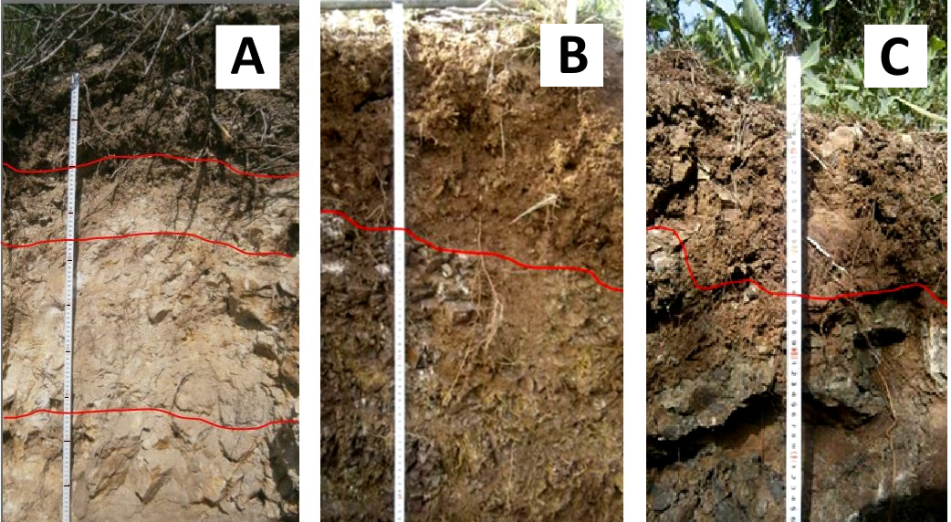
Soil samples analysis
Several physicochemical soil analyses were carried out: water content (%) was calculated using the loss on ignition method (LOI), bulk density (BD) (g/cm3) was measured using the core and pycnometer methods, clay (%) was determined according to the USDA method, pH using a pH-meter, electrical conductivity (EC) (dS m-1) by EC-meter. The total organic matter (TOM) (%) was determined using the wet digestion method; CaCO3 (%) using calcimeter method, and finally, cation exchange capacity (CEC) (Cmolc kg-1) was measured. All analysis methods were carried out according to [22].
Statistical analysis
The minimum value (Min); maximum value (Max); Mean; standard error (SE); Variance; standard deviation (SD); and Median, were calculated using SPSS software V.24. Furthermore, Pearson’s correlations between soil physicochemical characteristics for each land use were investigated. Additionally, the regression models between TOM and some soil characteristics were established.
Results and discussion
Soil characteristics in the study area
In total, 15 samples were collected from agricultural land, 5 samples were collected from rangeland, and 11 samples from forest land (Table 1). The pH of forest soils ranged between 7.10-8.20; clay content was 14.26-76.67%, and water content was 4.38-11.50%. The soil was not found to be saline but calcareous as the average CaCO3 was 41%. In rangeland soil pH was 7.70-8.00; CaCO3 was 50.99-78.46%, and BD was 1.02- 1.78 g/cm3. Remarkably, the average percentage of water content, clay, pH, and EC were higher in agricultural land than those in the other agroecosystems. These results could be attributed to intensive agricultural activities such as fertilization, irrigation, and crop rotation which affect these physicochemical properties.
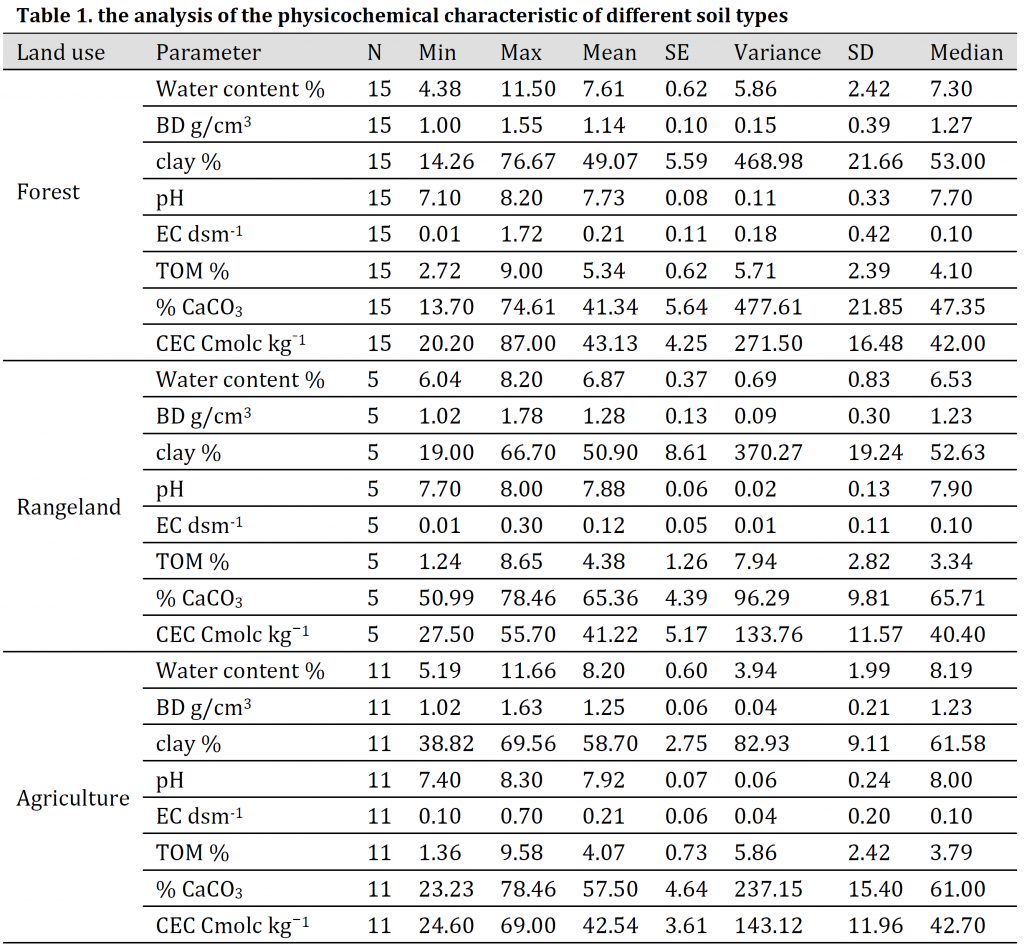
In the studied agroecosystems the TOM ranged between 2.72-9.00%, with an average of 5.34% in forest land, 1.24- 8.65%, with an average of 4.38% in rangeland, and 1.36- 9.58%, and an average of 4.07% in agricultural land. Notably, the average of TOM was the highest in the forest land followed by rangeland and agricultural land. The higher TOM content in the forest agroecosystem can be explained by the Lower decomposition and higher organic inputs under forest conditions. On the other hand, the lower TOM values in agricultural lands are attributed to the various agricultural activities such as cultivation and traditional tillage which accelerate organic matter decompositions, in addition to burning crop residues which is a commonly carried out procedure [15].
Correlations between soil characteristics
Correlation between different soil physicochemical soil properties can explain the relations between different soil properties. Correlation analysis results shown in (Fig. 2) indicated that under forest land, a positive significant (p<0.05) correlation between clay content and CEC, and between CEC and TOM were present (Fig. 2 A). In contrast, there was no significant (p<0.05) correlations between any of the studied soil properties in rangeland (Fig. 2 B). Analysis of agricultural land data (Fig. 2 C) showed a positive significant (p<0.05) correlation between water content and each of CEC and clay, and between clay and CEC.
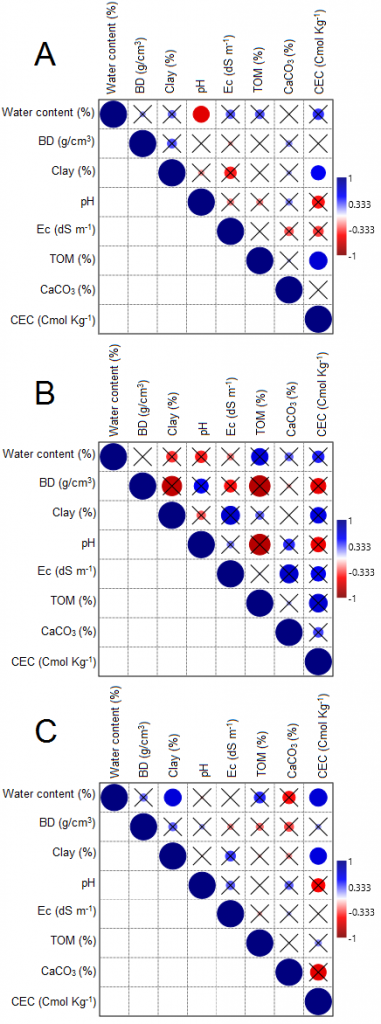
It is expected to observe a correlation between CEC with each of clay and TOM, as both of these components provide an adsorption surface with a negative charge for soil cations (Ca+2, Mg+2, K+, Na+). Additionally, high clay and TOM contents increase soil’s water capacity, as clay particles have a larger surface compared to sand and thus, they can hold larger amounts of water [23].
Correlations between total soil organic matter and some soil components
The correlations between TOM and some soil characteristics (CaCO3, CEC, clay, pH) were further analyzed. In forest land, a distinctive relation was obtained between CEC and TOM as can be seen in (Fig. 3). In contrast (Fig. 4) and (Fig. 5) revealed that no distinction relations were obtained between TOM and other soil components.
The Syrian agricultural sector plays a vital role in national development and contributes 14% of the national gross domestic product (GDP) [24]. Notably, the coastal region of Syria suffers from many issues such as deforestation and miss land use management [25]; soil erosion [26][27]; and climate change [28]. Therefore, taking into consideration the key role of organic matter in agricultural production in general, proper management of land resources especially its organic matter content is an essential step toward national development. Our study demonstrated that the average of TOM in the coast region of Syria ranged between 1.3 -9.58% with an average of 4.07% which refers to the proper agricultural practices in general; however, elevating the awareness of the organic component importance is crucial to enhance these figures further, especially in poor soils.
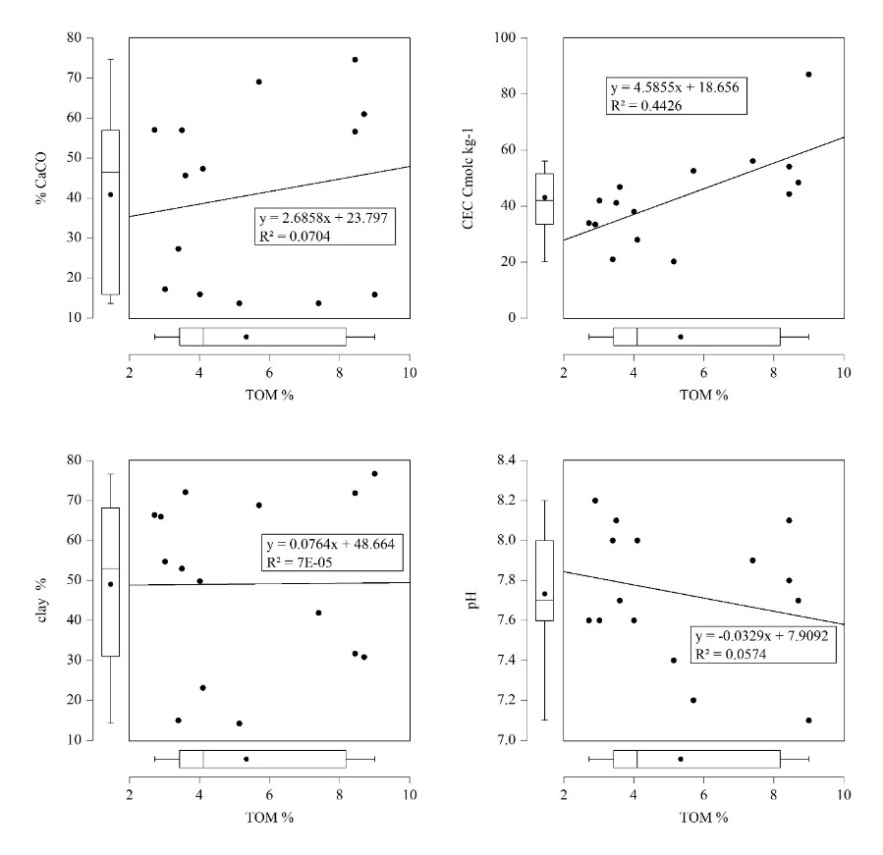
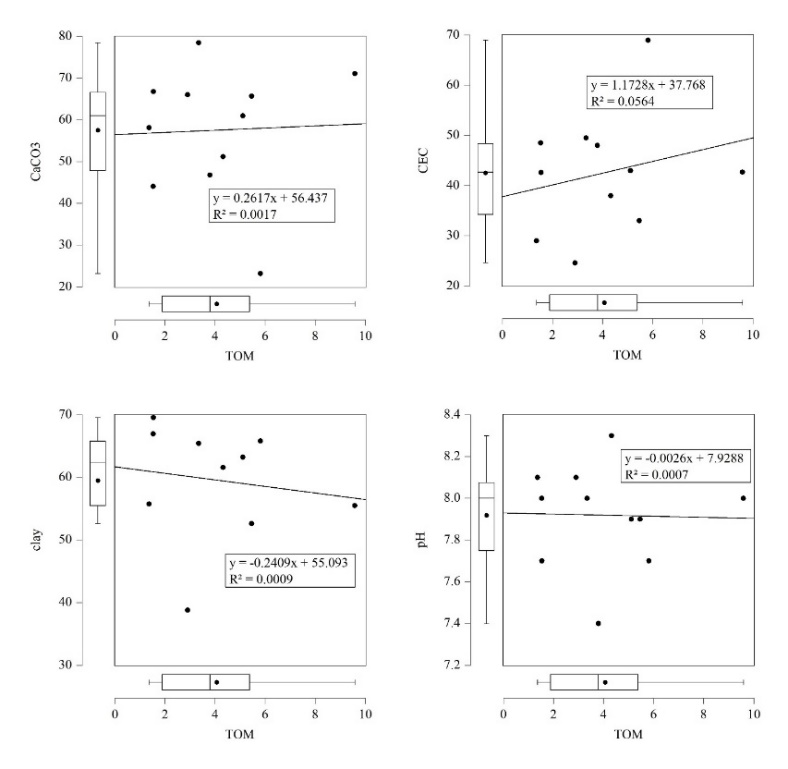
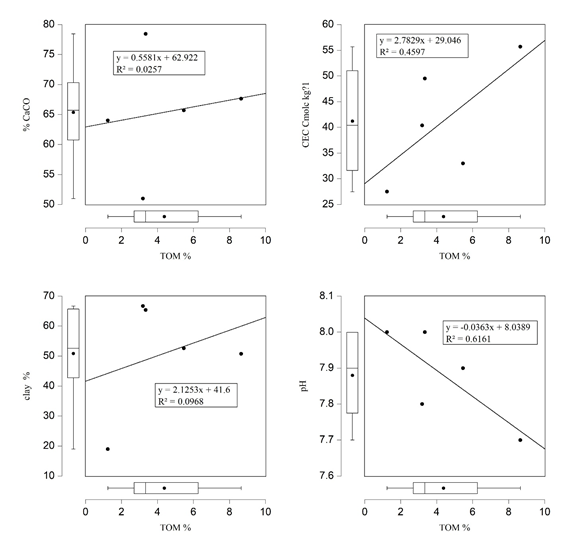
References
| 1 | Liaudanskiene I, Slepetiene A, Velykis A, Satkus A. Distribution of organic carbon in humic and granulodensimetric fractions of soil as influenced by tillage and crop rotation. Estonian J. Ecol. 2013;62(1). |
| 2 | Cotrufo MF, Conant RT, Paustian K. Soil organic matter dynamics: land use, management and global change. Plant Soil. 2011;338:1–3. DOI |
| 3 | Carter MR. Soil quality for sustainable land management. Agron J. 2002;94(1):38-47. DOI |
| 4 | Kalisz B, Lachacz A, Glazewski R. Transformation of some organic matter components in organic soils exposed to drainage. Turk J Agric For. 2010;34(3):245-56. |
| 5 | Silva JR, Silva DJ, Gava CA, Oliveira TC, Freitas MD. Carbon in humic fractions of organic matter in soil treated with organic composts under mango cultivation. Rev. Bras. Cienc. Solo. 2016;40. DOI |
| 6 | Alexandrova LN. Lab. Practical of soils analysis. Leningrad,Russia.1976. |
| 7 | Lichtfouse E, Chenu C, Baudin F, Leblond C, Da Silva M, Béhar F, Derenne S, Largeau C, Wehrung P, Albrecht P. A novel pathway of soil organic matter formation by selective preservation of resistant straight-chain biopolymers: chemical and isotope evidence. Org. Geochem. 1998;28(6):411-5. DOI |
| 8 | Hayes MH, Clapp CE. Humic substances: considerations of compositions, aspects of structure, and environmental influences. Soil Sci. 2001;166(11):723-37. |
| 9 | Piccolo A. The supramolecular structure of humic substances: a novel understanding of humus chemistry and implications in soil science. Adv. Agron. 2002;75:57-134. |
| 10 | West TO, Post WM. Soil organic carbon sequestration rates by tillage and crop rotation. Soil Sci Soc Am J. 2002;66(6):1930-46. DOI |
| 11 | Stergiadi M, Van Der Perk M, De Nijs T, Bierkens MF. Effects of climate change and land management on soil organic carbon dynamics and carbon leaching in northwestern Europe. Biogeosciences. 2016;13(5):1519-36. DOI |
| 12 | Martin M, Wattenbach M, Smith P, Meersmans J, Jolivet C, Boulonne L, Arrouays D. Spatial distribution of soil organic carbon stocks in France. Biogeosciences. 2011;8(5):1053-65. DOI |
| 13 | Parajuli PB, Duffy S. Evaluation of soil organic carbón and soil moisture content from agricultural fields in Mississippi. Open J. Soil Sci. 2013;3(2):81-90 DOI |
| 14 | Hobley EU, Wilson B. The depth distribution of organic carbon in the soils of eastern Australia. Ecosphere. 2016;7(1):e01214. DOI |
| 15 | Mohammed S, Khallouf A, Kiwan S, Alhenawi S, Ali H, Harsányi E, Kátai J, Habib H. Characterization of Major Soil Orders in Syria. Eurasian Soil Sci. 2020;53:420-9. DOI |
| 16 | Alsafadi K, Mohammed SA, Ayugi B. et al. Spatial–Temporal Evolution of Drought Characteristics Over Hungary Between 1961 and 2010. Pure Appl. Geophys. 2020. DOI |
| 17 | Mohammed S, Alsafadi K, Daher H, Gombos B, Mahmood S, Harsányi E. Precipitation pattern changes and response of vegetation to drought variability in the eastern Hungary. Bull Natl Res Cent. 2020;44:1-10. DOI |
| 18 | Mohammed S, Alsafadi K, Takács I, Harsányi E. Contemporary changes of greenhouse gases emission from the agricultural sector in the EU-27. Geology, Ecology, and Landscapes. 2019:1-6. DOI |
| 19 | Schmidt MW, Torn MS, Abiven S, Dittmar T, Guggenberger G, Janssens IA, Kleber M, Kögel-Knabner I, Lehmann J, Manning DA, Nannipieri P. Persistence of soil organic matter as an ecosystem property. Nature. 2011;478(7367):49-56. DOI |
| 20 | Amundson R, Biardeau L. Opinion: Soil carbon sequestration is an elusive climate mitigation tool. Proc. Natl. Acad. Sci. U.S.A. 2018;115(46):11652-6. DOI |
| 21 | Mohammed S, Habi H, Ali H, Alhenawi S, Kiwan S, Ghanem S, Alsafadi K, Brevik EC, Sulieman MM, Harsányi E. Soils of the Southern Syria-A big database for the future land management planning. Data Brief. 2020;31:105832. DOI |
| 22 | Ghanem S, Rukia A, Sulieman MM, Brevik EC, Mohammed S. Dataset on the Mediterranean soils from the coastal region of the Lattakia governorate, Syria. Data Brief. 2020;29:105254. DOI |
| 23 | Al-Majou H. The effect of clay mineralogy, assemblage of clay particles and hydric stress history in soil water content. Damascus university. J. Agric. Res. 2014;30(4):9-26. |
| 24 | Mohammed SA, Alkerdi A, Nagy J, Harsányi E. Syrian crisis repercussions on the agricultural sector: Case study of wheat, cotton and olives. Reg. Sci. Policy Pract. 2019;53(4):420-9. DOI |
| 25 | Abdo HG. Impacts of war in Syria on vegetation dynamics and erosion risks in Safita area, Tartous, Syria. Reg. Environ. Change. 2018;18(6):1707-19. DOI |
| 26 | Abdo H, Salloum J. Mapping the soil loss in Marqya basin: Syria using RUSLE model in GIS and RS techniques. Environ. Earth Sci. 2017;76(3):114. DOI |
| 27 | Mohammed S, Kbibo I, Alshihabi O, Mahfoud E. Studying rainfall changes and water erosion of soil by using the WEPP model in Lattakia, Syria. J. Agric. Sci. 2016;61(4):375-86. DOI |
| 28 | Mohammed SA, Fallah RQ. Climate change indicators in Alsheikh-Badr Basin (Syria). Geogr. Environ. Sustain. 2019;12(2):87-96. DOI |
Cite this article:
Ghanem, S., Rukia, A. Distribution of soil organic matter in the coastal region of Syria: A case study. DYSONA – Applied Science, 2020;1(2): 57-63. doi: 10.30493/das.2020.234950
